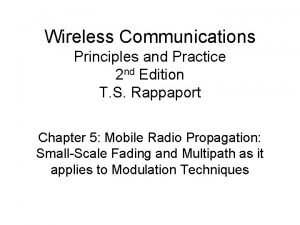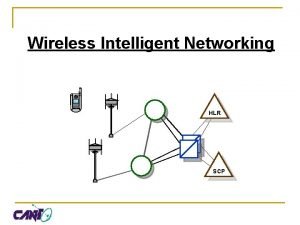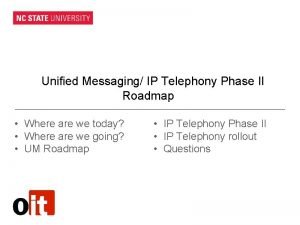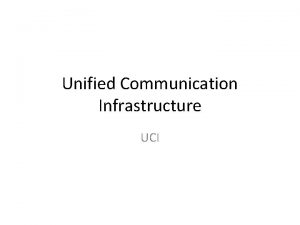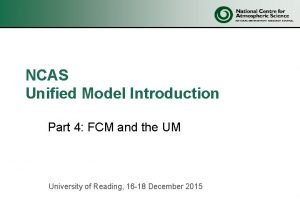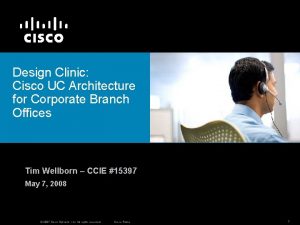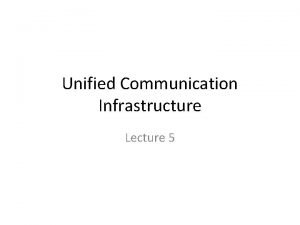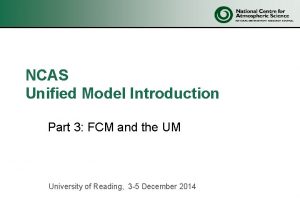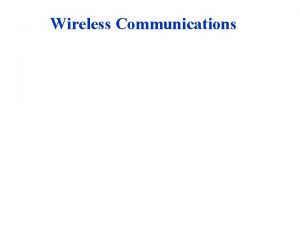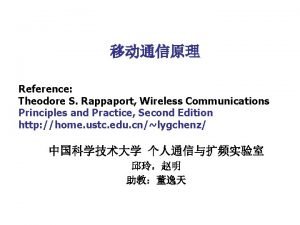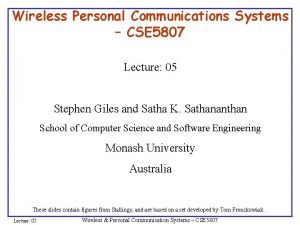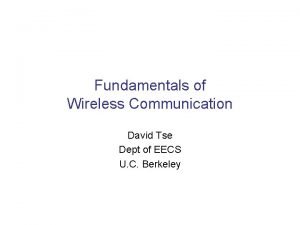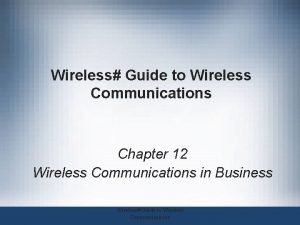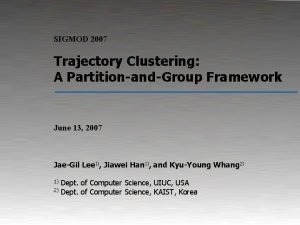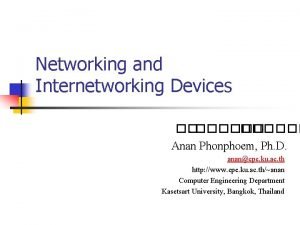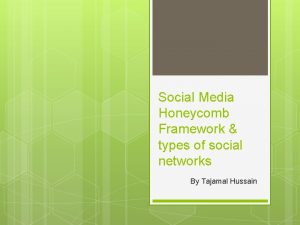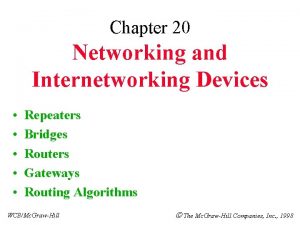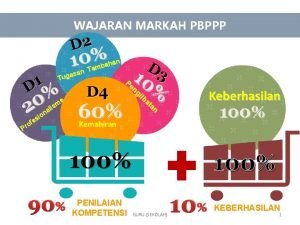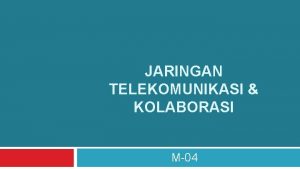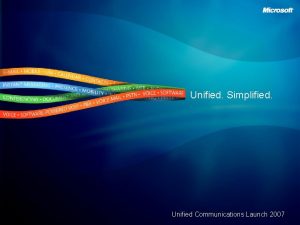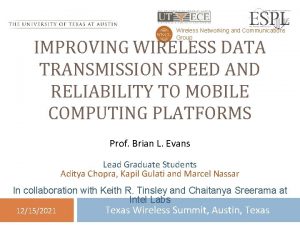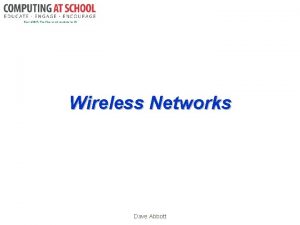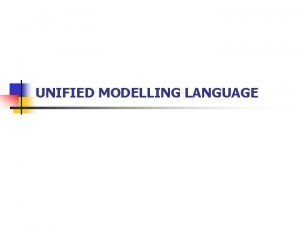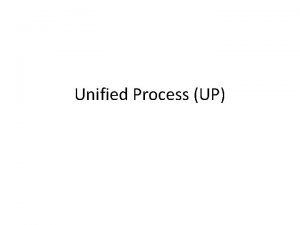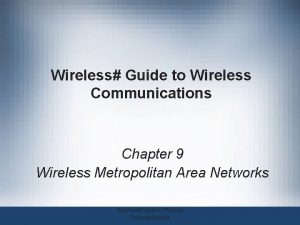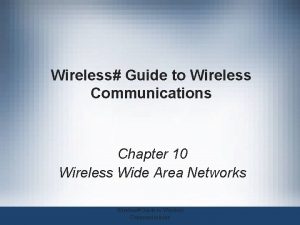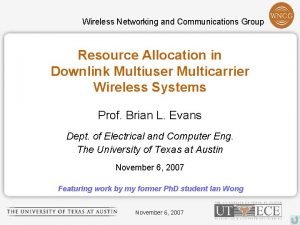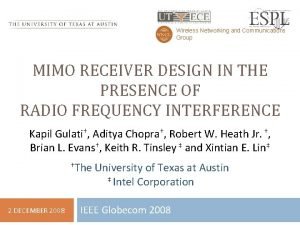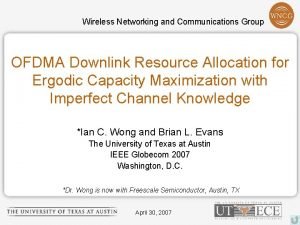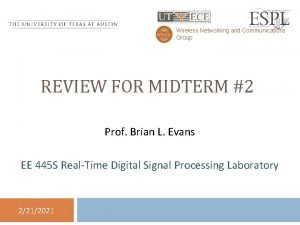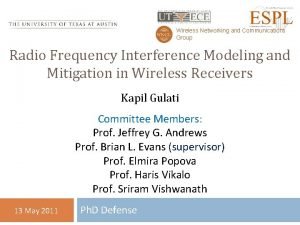Wireless Networking and Communications Group A Unified Framework




![Wireless Networking and Communications Group Related Work Max-min [Rhee & Cioffi, ‘ 00] Sum Wireless Networking and Communications Group Related Work Max-min [Rhee & Cioffi, ‘ 00] Sum](https://slidetodoc.com/presentation_image_h/1e47bb6eb5a33dacee11f91c6953f561/image-5.jpg)



































![Wireless Networking and Communications Group Questions? Relevant Jounal Publications [J 1] I. C. Wong Wireless Networking and Communications Group Questions? Relevant Jounal Publications [J 1] I. C. Wong](https://slidetodoc.com/presentation_image_h/1e47bb6eb5a33dacee11f91c6953f561/image-41.jpg)



![Wireless Networking and Communications Group Stochastic Programming Models [Ermoliev & Wets, 1988] • Non-anticipative Wireless Networking and Communications Group Stochastic Programming Models [Ermoliev & Wets, 1988] • Non-anticipative](https://slidetodoc.com/presentation_image_h/1e47bb6eb5a33dacee11f91c6953f561/image-45.jpg)




















- Slides: 65

Wireless Networking and Communications Group A Unified Framework for Optimal Resource Allocation in Multiuser Multicarrier Wireless Systems Ian C. Wong Supervisor: Prof. Brian L. Evans Committee: Prof. Jeffrey G. Andrews Prof. Gustavo de Veciana Prof. Robert W. Heath, Jr. Prof. David P. Morton Prof. Edward J. Powers, Jr. April 30, 2007

Wireless Networking and Communications Group Outline • • • • Background – OFDMA Resource Allocation Weighted-Sum Rate with Perfect Channel State Information – Related Work Weighted-Sum Rate with Partial Channel State Information – Summary of Contributions Rate Maximization with Proportional Rate Constraints – System Model Conclusion Weighted-Sum Rate with Perfect Channel State Information • Weighted-Sum Rate with Partial Channel State Information • Rate Maximization with Proportional Rate Constraints • Conclusion 2 April 30, 2007

Wireless Networking and Communications Group Orthogonal Frequency Division Multiple Access (OFDMA) • Used in IEEE 802. 16 d/e (now) and 3 GPP-LTE (2009) • Multiple users assigned different subcarriers – Inherits advantages of OFDM – Granular exploitation of diversity among users through channel state information (CSI) feedback User 1 . . . frequency Base Station (Subcarrier and power allocation) 3 April 30, 2007 User M

Wireless Networking and Communications Group OFDMA Resource Allocation • How do we allocate K data subcarriers and total power P to M users to optimize some performance metric? – E. g. IEEE 802. 16 e: K = 1536, M¼ 40 / sector • Very active research area – Difficult discrete optimization problem (NP-complete [Song & Li, 2005]) – Brute force optimal solution: Search through MK subcarrier allocations and determine power allocation for each 4 April 30, 2007
![Wireless Networking and Communications Group Related Work Maxmin Rhee Cioffi 00 Sum Wireless Networking and Communications Group Related Work Max-min [Rhee & Cioffi, ‘ 00] Sum](https://slidetodoc.com/presentation_image_h/1e47bb6eb5a33dacee11f91c6953f561/image-5.jpg)
Wireless Networking and Communications Group Related Work Max-min [Rhee & Cioffi, ‘ 00] Sum Rate [Jang, Lee &Lee, ’ 02] Proportional [Wong, Shen, Andrews& Evans, ‘ 04] Max-utility [Song&Li, ‘ 05] Weighted-sum [Seong, Mehsini&Cioffi, ’ 06] [Yu, Wang&Giannakis] Ergodic Rates No Yes No No* No Discrete Rates No No No Yes No User prioritization No No Yes Yes Practically optimal No Yes No No Yes** Linear complexity No No Yes*** Imperfect CSI No No No Do not require CDI Yes No Yes Yes Method Criteria Formulation Solution (algorithm) Assumption (channel knowledge) * Considered some form of temporal diversity by maximizing an exponentially windowed running average of the rate ** Independently developed a similar instantaneous continuous rate maximization algorithm *** Only for instantaneous continuous rate case, but was not shown in their papers 5 April 30, 2007

Wireless Networking and Communications Group Summary of Contributions Previous Research Our Contributions Formulation Solution Instantaneous rate • Unable to exploit time-varying wireless channels Ergodic rate (continuous and discrete) • Exploits time-varying nature of the wireless channel Constraint-relaxation • One large constrained convex optimization problem • Resort to sub-optimal heuristics ((O(MK 22) complexity) Dual optimization • Multiple small optimization problems w/closed-form solutions • Practically optimal with O(MK) complexity • Adaptive algorithms also proposed Assumption Perfect channel knowledge • Unrealistic due to channel estimation errors and delay Imperfect channel knowledge • Allocate based on statistics of channel estimation/prediction errors 6 April 30, 2007

Wireless Networking and Communications Group OFDMA Signal Model • Downlink OFDMA with K subcarriers and M users – Perfect time and frequency synchronization – Delay spread less than guard interval • Received K-length vector for mth user at nth symbol Diagonal gain matrix Diagonal channel matrix 7 April 30, 2007 Noise vector

Wireless Networking and Communications Group Statistical Wireless Channel Model • Time-domain channel • Frequency-domain channel – Stationary and ergodic – Complex normal and independent across taps i and users m – Stationary and ergodic – Complex normal with correlated channel gains across subcarriers 8 April 30, 2007

Wireless Networking and Communications Group Outline • Background • Weighted-Sum Rate with Perfect Channel State Information – Continuous Rate Case – Discrete Rate Case – Numerical Results • Weighted-Sum Rate with Partial Channel State Information • Rate Maximization with Proportional Rate Constraints • Conclusion 9 April 30, 2007

Wireless Networking and Communications Group Ergodic Continuous Rate Maximization: Perfect CSI and CDI [Wong & Evans, 2007 a] Anticipative and infinite dimensional stochastic program Constant weights Powers to determine Channel-to-noise ratio (CNR) Average power constraint Constant user weights: Space of feasible power allocation functions: Subcarrier capacity: 10 April 30, 2007

Wireless Networking and Communications Group Dual Optimization Framework “Max-dual user selection” Dual problem: “Multi-level waterfilling” Duality gap 11 April 30, 2007

Wireless Networking and Communications Group *Optimal Subcarrier and Power Allocation “Max-dual user selection” Power Marginal dual “Multi-level waterfilling” *Independently discovered by [Yu, Wang, & Giannakis, submitted] and [Seong, Mehsini, & Cioffi, 2006] for instantaneous rate case 12 April 30, 2007

Wireless Networking and Communications Group Computing the Expected Dual • Dual objective requires an M-dimensional integral – Numerical quadrature feasible only for M=2 or 3 • O(NM) complexity (N - number of function evaluations) – For M>3, Monte Carlo methods are feasible, but are overly complex and converge slowly • Derive the pdf of – Maximal order statistic of INID random variables – Requires only a 1 -D integral (O(NM) complexity) 13 April 30, 2007

Wireless Networking and Communications Group Optimal Resource Allocation – Ergodic Capacity with Perfect CSI Initialization PDF of CNR O(INM) Runtime CNR Realization O(MK) M – No. of users K – No. of subcarriers I – No. of line-search iterations N – No. of function evaluations for integration O(K) 14 April 30, 2007

Wireless Networking and Communications Group Ergodic Discrete Rate Maximization: Perfect CSI and CDI [Wong & Evans, submitted] Anticipative and infinite dimensional stochastic program Discrete Rate Function: Uncoded BER = 10 -3 15 April 30, 2007

Wireless Networking and Communications Group Dual Optimization Framework “Slope-interval selection” “Multi-level fading inversion” wm=1, =1 16 April 30, 2007

Wireless Networking and Communications Group Optimal Resource Allocation – Ergodic Discrete Rate with Perfect CSI PDF of CNR Initialization O(INML) Runtime CNR Realization O(MKlog(L)) O(MK) O(K) M – No. of users; K – No. of subcarriers; L – No. of rate levels; I – No. of line-search iterations; N – No. of function evaluations for integration 17 April 30, 2007

Wireless Networking and Communications Group Simulation Results OFDMA Parameters (3 GPP-LTE) 18 April 30, 2007 Channel Simulation

Wireless Networking and Communications Group Two-User Continuous Rate Region 76 used subcarriers Erg. Rates Algorithm Inst. Rates Algorithm 5 d. B 47. 91 - 10 d. B 50. 09 - 15 d. B 53. 73 - 5 d. B 8. 091 8. 344 10 d. B 7. 727 8. 333 15 d. B 7. 936 8. 539 5 d. B 7. 936 . 0251 10 d. B 5. 462 . 0226 15 d. B 5. 444 . 0159 SNR No. of function evaluations (N) No. of Iterations (I) Relative Gap (x 10 -6) 19 April 30, 2007

Wireless Networking and Communications Group Two-User Discrete Rate Region 76 used subcarriers SNR No. of function evaluations (N) No. of Iterations (I) Relative Gap (x 10 -4) 20 April 30, 2007 Erg. Rates Algorithm Inst. Rates Algorithm 5 d. B 47. 91 - 10 d. B 50. 09 - 15 d. B 53. 73 - 5 d. B 9. 818 17. 24 10 d. B 10. 550 17. 20 15 d. B 9. 909 17. 30 5 d. B 0. 8711 3. 602 10 d. B 0. 9507 1. 038 15 d. B 0. 5322 0. 340

Wireless Networking and Communications Group Sum Rate Versus Number of Users 76 used subcarriers Continuous Rate Discrete Rate 21 April 30, 2007

Wireless Networking and Communications Group Outline • Background • Weighted-Sum Rate with Perfect Channel State Information • Weighted-Sum Rate with Partial Channel State Information – Continuous Rate Case – Discrete Rate Case – Numerical Results • Rate Maximization with Proportional Rate Constraints • Conclusion 22 April 30, 2007

Wireless Networking and Communications Group Partial Channel State Information Model • Stationary and ergodic channel gains • MMSE channel prediction MMSE Channel Prediction Conditional PDF of channel-to-noise ratio (CNR) – Non-central Chi-squared CNR: Normalized error variance: 23 April 30, 2007

Wireless Networking and Communications Group Continuous Rate Maximization: Partial CSI with Perfect CDI [Wong & Evans, submitted] Nonlinear integer stochastic program • Maximize conditional expectation given the estimated CNR – Power allocation a function of predicted CNR • Instantaneous power constraint – Parametric analysis is not required • a 24 April 30, 2007

Wireless Networking and Communications Group Dual Optimization Framework “Multi-level waterfilling on conditional expected CNR” 1 -D Integral (> 50 iterations) Computational bottleneck 1 -D Root-finding (<10 iterations) 25 April 30, 2007

Wireless Networking and Communications Group Power Allocation Function Approximation • Use Gamma distribution to approximate the Noncentral Chi-squared distribution [Stüber, 2002] • Approximately 300 times faster than numerical quadrature (tic-toc in Matlab) 26 April 30, 2007

Wireless Networking and Communications Group Optimal Resource Allocation – Ergodic Capacity given Partial CSI Conditional PDF Runtime O(MKI (Ip+Ic)) Predicted CNR O(1) O(MK) M – No. of users K – No. of subcarriers I – No. of line-search iterations Ip – No. of zero-finding iterations for power allocation function Ic – No. of function evaluations for numerical integration of expected capacity 27 April 30, 2007 O(K)

Wireless Networking and Communications Group Discrete Rate Maximization: Partial CSI with Perfect CDI [Wong & Evans, 2007 b] Nonlinear integer stochastic program Rate levels: Derived Average rate function given partial CSI: closed-form expressions Feasible set: Power allocation function given partial CSI: 28 April 30, 2007

Wireless Networking and Communications Group Power Allocation Functions Optimal Power Allocation: Multilevel Fading Inversion (MFI): Predicted CNR: 29 April 30, 2007

Wireless Networking and Communications Group Dual Optimization Framework • Bottleneck: computing rate/power functions • Rate/power functions independent of multiplier – Can be computed and stored before running search 30 April 30, 2007

Wireless Networking and Communications Group Optimal Resource Allocation – Ergodic Discrete Rate given Partial CSI Conditional PDF Runtime O(MK(I +L)) Predicted CNR O(1) O(K) M – No. of users K – No. of subcarriers L – No. of rate levels I – No. of line-search iterations 31 April 30, 2007

Wireless Networking and Communications Group Simulation Parameters (3 GPP-LTE) Channel Snapshot 32 April 30, 2007

Wireless Networking and Communications Group Two-User Continuous Rate Region No. of line search iterations (I) Relative Gap (x 10 -4) Complexity 5 d. B 8. 599 10 d. B 8. 501 15 d. B 8. 686 5 d. B 0. 084 10 d. B 0. 057 15 d. B 0. 041 O(MKI (Ip+Ic)) M – No. of users; K – No. of subcarriers I – No. of line-search iterations Ip – No. of zero-finding iterations for power allocation function Ic – No. of function evaluations for numerical integration of expected capacity 33 April 30, 2007

Wireless Networking and Communications Group Two-User Discrete Rate Region No. of rate levels (L) = 4 BER constraint = 10 -3 No. of line search iterations (I) Relative Gap (x 10 -4) Complexity 5 d. B 21. 33 10 d. B 21. 12 15 d. B 21. 15 5 d. B 71. 48 10 d. B 7. 707 15 d. B 5. 662 O(MK(I +L)) M – No. of users K – No. of subcarriers; I – No. of line search iterations L – No. of discrete rate levels 34 April 30, 2007

Wireless Networking and Communications Group No. of rate levels (L) = 4 BER constraint = 10 -3 Average BER Comparison Per-subcarrier Prediction Error Variance BER Per-subcarrier Average BER Subcarrier Index 35 April 30, 2007

Wireless Networking and Communications Group Outline • • • Background Weighted-Sum Rate with Perfect Channel State Information Weighted-Sum Rate with Partial Channel State Information Rate Maximization with Proportional Rate Constraints Conclusion 36 April 30, 2007

Wireless Networking and Communications Group Ergodic Sum Rate Maximization with Proportional Ergodic Rate Constraints Ergodic Sum Capacity Average Power Constraint Proportional Rate Constraints • Allows definitive prioritization among users [Shen, Andrews, & Evans, 2005] • Equivalent to weighted-sum rate with optimally chosen weights • Developed adaptive algorithms using stochastic approximation – Convergence w. p. 1 without channel distribution information 37 April 30, 2007

Wireless Networking and Communications Group Comparison with Previous Work Proportional [Wong, Shen, Andrews& Evans, ‘ 04] Max-utility [Song&Li, ‘ 05] Weighted [Seong, Mehsini &Cioffi, ’ 06] [Yu, Wang& Giannakis] Weighted or Prop. D-Rate P-CSI Weighted or Prop. D-Rate I-CSI Adaptive Ergodic Rates No No* No Yes Yes Discrete Rates No Yes Yes User prioritization Yes Yes Yes Practically optimal No No Yes Yes Linear complexity No No Yes** Yes Yes Imperfect CSI No No Yes Do not require CDI Yes Yes No No Yes Method Criteria Formulation Solution (algorithm) Assumption (channel knowledge) * Considered some form of temporal diversity by maximizing an exponentially windowed running average of the rate ** Only for instantaneous continuous rate case, but was not shown in their papers 38 April 30, 2007

Wireless Networking and Communications Group Conclusion • Developed a unified algorithmic framework for optimal OFDMA downlink resource allocation – Based on dual optimization techniques • Practically optimal with linear complexity – Applicable to a broad class of problem formulations • Natural Extensions – Uplink OFDMA – OFDMA with minimum rate constraints – Power/BER minimization 39 April 30, 2007

Wireless Networking and Communications Group Future Work • Multi-cell OFDMA and Single Carrier-FDMA – Distributed algorithms that allow minimal base-station coordination to mitigate inter-cell interference • MIMO-OFDMA – Capacity-based analysis – Other MIMO transmission schemes • Multi-hop OFDMA – Hop-selection 40 April 30, 2007
![Wireless Networking and Communications Group Questions Relevant Jounal Publications J 1 I C Wong Wireless Networking and Communications Group Questions? Relevant Jounal Publications [J 1] I. C. Wong](https://slidetodoc.com/presentation_image_h/1e47bb6eb5a33dacee11f91c6953f561/image-41.jpg)
Wireless Networking and Communications Group Questions? Relevant Jounal Publications [J 1] I. C. Wong and B. L. Evans, "Optimal Resource Allocation in OFDMA Systems with Imperfect Channel Knowledge, “ IEEE Trans. on Communications. , submitted Oct. 1, 2006, resubmitted Feb. 13, 2007. [J 2] I. C. Wong and B. L. Evans, "Optimal OFDMA Resource Allocation with Linear Complexity to Maximize Ergodic Rates, " IEEE Trans. on Wireless Communications, submitted Sept. 17, 2006, and resubmitted on Feb. 3, 2007. Relevant Conference Publications [C 1] I. C. Wong and B. L. Evans, ``Optimal OFDMA Subcarrier, Rate, and Power Allocation for Ergodic Rates Maximization with Imperfect Channel Knowledge'', Proc. IEEE Int. Conf. on Acoustics, Speech, and Signal Proc. , April 16 -20, 2007, Honolulu, HI USA. [C 2] I. C. Wong and B. L. Evans, ``Optimal OFDMA Resource Allocation with Linear Complexity to Maximize Ergodic Weighted Sum Capacity'', Proc. IEEE Int. Conf. on Acoustics, Speech, and Signal Proc. , April 16 -20, 2007, Honolulu, HI USA. [C 3] I. C. Wong and B. L. Evans, ``Optimal Downlink OFDMA Subcarrier, Rate, and Power Allocation with Linear Complexity to Maximize Ergodic Weighted-Sum Rates'', Proc. IEEE Int. Global Communications Conf. , November 26 -30, 2007 Washington, DC USA, submitted. [C 4] I. C. Wong and B. L. Evans, ``OFDMA Resource Allocation for Ergodic Capacity Maximization with Imperfect Channel Knowledge'', Proc. IEEE Int. Global Communications Conf. , November 2630, 2007 Washington, DC USA, submitted. 41 April 30, 2007

Wireless Networking and Communications Group Backup Slides • • • Notation Related Work Stoch. Prog. Models C-Rate, P-CSI Dual objective Instantaneous Rate D-Rate, P-CSI Dual Objective PDF of D-Rate Duality Gap D-Rate, I-CSI Rate/power functions Proportional Rates - adaptive Summary of algorithms 42 April 30, 2007

Wireless Networking and Communications Group Notation Glossary 43 April 30, 2007

Wireless Networking and Communications Group Related Work • OFDMA resource allocation with perfect CSI – Ergodic sum rate maximizatoin [Jang, Lee, & Lee, 2002] – Weighted-sum rate maximization [Hoo, Halder, Tellado, & Cioffi, 2004] [Seong, Mohseni, & Cioffi, 2006] [Yu, Wang, & Giannakis, submitted] – Minimum rate maximization [Rhee & Cioffi, 2000] – Sum rate maximization with proportional rate constraints [Wong, Shen, Andrews, & Evans, 2004] [Shen, Andrews, & Evans, 2005] – Rate utility maximization [Song & Li, 2005] • Single-user systems with imperfect CSI – Single-carrier adaptive modulation [Goeckel, 1999] [Falahati, Svensson, Ekman, & Sternad, 2004] – Adaptive OFDM [Souryal & Pickholtz, 2001][Ye, Blum, & Cimini 2002] [Yao & Giannakis, 2004] [Xia, Zhou, & Giannakis, 2004] 44 April 30, 2007
![Wireless Networking and Communications Group Stochastic Programming Models Ermoliev Wets 1988 Nonanticipative Wireless Networking and Communications Group Stochastic Programming Models [Ermoliev & Wets, 1988] • Non-anticipative](https://slidetodoc.com/presentation_image_h/1e47bb6eb5a33dacee11f91c6953f561/image-45.jpg)
Wireless Networking and Communications Group Stochastic Programming Models [Ermoliev & Wets, 1988] • Non-anticipative – Decisions are made based only on the distribution of the random quantities – Also known as non-adaptive models • Anticipative – Decisions are made based on the distribution and the actual realization of the random quantities – Also known as adaptive models • 2 -Stage recourse models – Non-anticipative decision for the 1 st stage – Recourse actions for the second stage based on the realization of the random quantities 45 April 30, 2007

Wireless Networking and Communications Group C-Rate P-CSI Dual Objective Derivation Lagrangian: Dual objective Linearity of E[¢] Separability of objective Power a function of RV realization m, k not independent but identically distributed across k 46 April 30, 2007 Exclusive subcarrier assignment

Wireless Networking and Communications Group Optimal Resource Allocation – Instantaneous Capacity with Perfect CSI Runtime CNR Realization O(IMK) O(1) M – No. of users K – No. of subcarriers I – No. of line-search iterations N – No. of function evaluations for integration O(K) 47 April 30, 2007

Wireless Networking and Communications Group Discrete Rate Perfect CSI Dual Optimization • Discrete rate function is discontinuous – Simple differentiation not feasible • Given , for all , we have • L candidate power allocation values • Optimal power allocation: 48 April 30, 2007

Wireless Networking and Communications Group PDF of Discrete Rate Dual • Derive the pdf of 49 April 30, 2007

Wireless Networking and Communications Group Performance Assessment - Duality Gap 50 April 30, 2007

Wireless Networking and Communications Group Duality Gap Illustration M=2 K=4 51 April 30, 2007

Wireless Networking and Communications Group Sum Power Discontinuity M=2 K=4 52 April 30, 2007

Wireless Networking and Communications Group BER/Power/Rate Functions • Impractical to impose instantaneous BER constraint when only partial CSI is available – Find power allocation function that fulfills the average BER constraint for each discrete rate level – Given the power allocation function for each rate level, the average rate can be computed • Derived closed-form expressions for average BER, power, and average rate functions 53 April 30, 2007

Wireless Networking and Communications Group Closed-form Average Rate and Power allocation function: Average rate function: Marcum-Q function 54 April 30, 2007

Wireless Networking and Communications Group Ergodic Sum Rate Maximization with Proportional Ergodic Rate Constraints Ergodic Sum Capacity Average Power Constraint Ergodic Rate for User m Developed adaptive algorithm without CDI Proportionality Constants • Allows more definitive prioritization among users • Traces boundary of capacity region with specified ratio 55 April 30, 2007

Wireless Networking and Communications Group Dual Optimization Framework • Reformulated as weighted-sum rate problem with properly chosen weights Multiplier for rate power constraint “Multi-level waterfilling with max-dual user selection” 56 April 30, 2007

Wireless Networking and Communications Group Projected Subgradient Search Power constraint multiplier search Rate constraint multiplier vector search Multiplier Projection iterates Step sizes Subgradients Derived pdfs for efficient 1 -D Integrals Per-user ergodic rate: 57 April 30, 2007

Wireless Networking and Communications Group Optimal Resource Allocation – Ergodic Proportional Rate with Perfect CSI Initialization PDF of CNR O(I NM 2) Runtime CNR Realization O(MK) M – No. of users K – No. of subcarriers I – No. of subgradient search iterations N – No. of function evaluations for integration O(K) 58 April 30, 2007

Wireless Networking and Communications Group Adaptive Algorithms for Rate Maximization Without Channel Distribution Information (CDI) • Previous algorithms assumed perfect CDI – Distribution identification and parameter estimation required in practice – More suitable for offline processing • Adaptive algorithms without CDI – Low complexity and suitable for online processing – Based on stochastic approximation methods 59 April 30, 2007

Wireless Networking and Communications Group Solving the Dual Problem Using Stochastic Approximation Power constraint multiplier Multiplier search iterates Rate constraint multiplier vector search Projection Step sizes Subgradients Averaging Subgradient time constant approximates Projected subgradient iterations across time with subgradient averaging - Proved convergence to optimal multipliers with probability one 60 April 30, 2007

Wireless Networking and Communications Group Subgradient Approximates “Instantaneous multi-level waterfilling with max-dual user selection” 61 April 30, 2007

Wireless Networking and Communications Group Optimal Resource Allocation. Ergodic Proportional Rate without CDI Weighted-sum, Discrete Rate and Partial CSI are special cases of this algorithm 62 April 30, 2007

Wireless Networking and Communications Group Two-User Capacity Region OFDMA Parameters (3 GPP-LTE) 1 = 0. 1 -0. 9 (0. 1 increments) 2 = 1 - 1 63 April 30, 2007

Evolution of the Iterates for 1=0. 1 and 2 = 0. 9 Power constraint Multipliers Power Rate constraint Multipliers User Rates Wireless Networking and Communications Group 64 April 30, 2007

Wireless Networking and Communications Group Summary of the Resource Allocation Algorithms Per-symbol Complexity Relative Gap Order of Magnitude Sum-Rate at w=[. 5, . 5], SNR=5 d. B WS Cont. Rates Perfect CSI – Ergodic O(INM) O(MK) 10 -6 2. 40 WS Cont. Rates Perfect CSI – Inst. - O(IMK) 10 -8 2. 39 WS Disc. Rates Perfect CSI – Ergodic O(INML) O(MKlog. L) 10 -5 1. 20 WS Disc. Rates Perfect CSI – Inst. - O(IMKlog. L) 10 -4 1. 10 WS Cont. Rates Partial CSI - O(MKI (Ip+Ic)) 10 -6 2. 37 WS Disc. Rates Partial CSI - O(MK(I +L)) 10 -4 1. 09 Prop. Cont. Rates Perfect CSI with CDI - Ergodic O(I NM 2) O(MK) 10 -6 2. 40 Prop. Cont. Rates Perfect CSI without CDI - Ergodic - O(MK) - 2. 40 Algorithm Initialization Complexity 65 April 30, 2007
 Business data communications and networking
Business data communications and networking Business data communication and networking
Business data communication and networking Introduction to data communications and networking
Introduction to data communications and networking Business data communications and networking
Business data communications and networking Sdn introduction
Sdn introduction Telecommunications the internet and wireless technology
Telecommunications the internet and wireless technology Geomerty
Geomerty Any time interrogation call flow
Any time interrogation call flow Wireless networking definition
Wireless networking definition Unified communications open source
Unified communications open source Open platform communications unified architecture
Open platform communications unified architecture Ncas introduction
Ncas introduction Asterisk open source technology
Asterisk open source technology Device management unified communications
Device management unified communications What is cucm
What is cucm Bt business unified communications solutions
Bt business unified communications solutions Unified communications roadmap
Unified communications roadmap Hp unified communications
Hp unified communications Uci cisco
Uci cisco Unified communications evolution
Unified communications evolution Hosted collaboration solution
Hosted collaboration solution Unified communications for financial services
Unified communications for financial services Virtual reality unified communications
Virtual reality unified communications Unified communication
Unified communication Who are puma unified communications
Who are puma unified communications Unified communications presentation
Unified communications presentation Unified communications command suite
Unified communications command suite Grapevine unified communications
Grapevine unified communications Processing model
Processing model Unified communications infrastructure
Unified communications infrastructure Who are puma unified communications
Who are puma unified communications Guide to wireless communications
Guide to wireless communications Andrea goldsmith wireless communications
Andrea goldsmith wireless communications Subsea wireless communications
Subsea wireless communications Theodore s rappaport wireless communications
Theodore s rappaport wireless communications Cse
Cse David tse wireless communications
David tse wireless communications Guide to wireless communications
Guide to wireless communications Unified architecture framework example
Unified architecture framework example Dhs trusted tester certification
Dhs trusted tester certification Crisis communications working group
Crisis communications working group Tactical communications group
Tactical communications group Panasonic communications co ltd
Panasonic communications co ltd Conceptual vs theoretical framework
Conceptual vs theoretical framework Trajectory clustering: a partition-and-group framework
Trajectory clustering: a partition-and-group framework Dispositional framework vs regulatory framework
Dispositional framework vs regulatory framework Theoretical framework vs conceptual framework
Theoretical framework vs conceptual framework Theoretical framework
Theoretical framework Dispositional framework vs regulatory framework
Dispositional framework vs regulatory framework Theoretical framework
Theoretical framework Wired and wireless media
Wired and wireless media Anova within group and between group
Anova within group and between group Voluntary group and involuntary group examples
Voluntary group and involuntary group examples Amino group and carboxyl group
Amino group and carboxyl group Amino group and carboxyl group
Amino group and carboxyl group Group 1 vs group 2 specialties
Group 1 vs group 2 specialties Joining together group theory and group skills
Joining together group theory and group skills Decision tree
Decision tree Social networking advantage and disadvantage
Social networking advantage and disadvantage Persuation and networking
Persuation and networking Disadvantages of networking computers
Disadvantages of networking computers Ictii
Ictii Data communication and networking assignment questions
Data communication and networking assignment questions Networking and internetworking devices
Networking and internetworking devices Jalinan dan jaringan (networking and linkages)
Jalinan dan jaringan (networking and linkages) Pengertian jaringan telekomunikasi
Pengertian jaringan telekomunikasi






